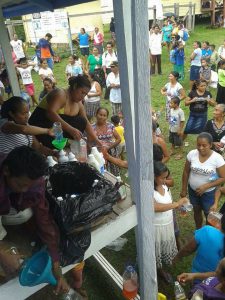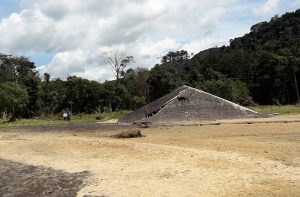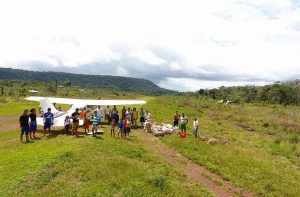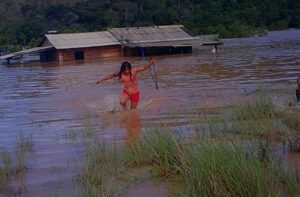-water continues to recede
AS water continues to recede in the flood-affected areas in Region Eight, people are beginning to see the real impact of the flash floods which took Waipa, Kanapang, Kopinang, Chiung Mouth, Itabac, Kaibarupaui and Chenapau by surprise.
Reports coming out of these areas indicate that 22 houses in Kaibarupaui have been completely destroyed, while 26 houses remain under water.

The situation is the same for the other villages with the main access road at Kanapang completely washed away.
After visiting some of the flood-affected areas on Sunday, Amerindian People’s Association (APA) representative, Michael McGarrell, who hails from Chenapau Village, told the Guyana Chronicle that “the water is receding in all locations.”
“People are now beginning to really see the impact of the flood. In Kaibarupaui, 22 houses have been completely destroyed, 26 still under water. Most people have lost everything,” McGarrell said, as he painted a vivid picture of the situation. “Thankfully,” he said, there has been no casualty as result of the flash flood.
Over at Waipa, the water is receding, however, it remains high at the moment, the APA representative reported.
“At Kanapang, the floodwater is receding, but I don’t know the exact magnitude of the damage there,” he said.
However, McGarrell was able to confirm that the road leading to the village has been washed away.
“Road access to Kanapang has been cut off until we find an alternative route,” he posited, while disclosing that the community is now being accessed by river from Orinduik.
RISING
APA Executive Member Laura George told the Guyana Chronicle that as of Sunday, the Ireng River, which separates Guyana from Brazil, was rising again, noting that the damage done has been significant.

“The flood has rendered the farms useless,” she posited, while emphasising that many of the farms are water-logged and severely damaged.
Given the situation, George said residents in the affected areas have informed the APA that they will need a supply of food for at least one year.
“Their farms are useless. Their domestic water supply has been compromised. It is smelly, and when they bathe, it’s itching their skin,” George reported.
Currently, there are urgent calls for tarpaulins to assist residents whose homes were washed away or who are otherwise affected by the floods.
Reflecting on the entire situation, George said many of the families have been left with “nothing” and are clearly devastated.
“They never had a flood like this, so high and so extreme, never to this magnitude and they are traumatised. When you see fathers cry, it is sad. They have never seen water rushing the way it did. It wasn’t a regular flood,” the APA Executive posited.
In recent days, relief efforts have been upped by the authorities, including the Civil Defence Commission (CDC), which established a Forward Operations Station at Orinduik.
Minister within the Ministry of Indigenous People’s Affairs Valerie Garrido-Lowe, led a team by boat to Waipa and Kaibarupai. The relief supplies consist mainly of food, medical supplies, clothing and water-purification agents. The APA has also transported food supplies to Mahdia for shipment to Orinduik, from where it will be boated upriver to the affected communities.
PERSISTENT RAINFALL
The floods have been caused by persistent rainfall over the past two weeks, which resulted in several waterways surpassing their optimum levels. In addition, reports are that the Ireng River, which lies on Guyana’s border with Brazil, overtopped, and as a result, several nearby villages were inundated.

Several government agencies, including the Ministry of State, Ministry of Indigenous People’s Affairs, the Ministry of Public Health and the CDC are coordinating relief efforts.
The Department of Public Information (DPI) stated on Friday that the CDC has conducted an aerial reconnaissance of the affected areas. There have been no reported deaths, missing persons or serious injuries.
The villages are located mainly in valley areas, where water from the excessive rainfall pooled and resulted in excessive flooding, the DPI stated. Villagers have relocated to higher ground in proximity to the various villages.
According to a release, the CDC has received reports from regional authorities that several villages in Region Seven have also suffered flooding, but not to the level of severity of the villages in Region Eight.

The villages affected in Region Seven are Purima, Kako, Jawalla, Phillipi, Kamarang and Duebamang. The Region Seven Regional Disaster Risk Management Systems (RDRMS) and Regional Disaster Risk Management Committee (RDRMC) have been activated. A team is being deployed to the affected villages to conduct assessments and reconnaissance. Mainly farmlands and some residences have been flooded in the Region Seven villages.
Members of the public who wish to make donations to the flood-relief efforts are asked to do so to the CDC headquarters on Thomas Road. CDC telephone numbers are 226 1114, 226 8815, 226 1027, 225 5847 and email info@cdc.gy and opsandtrg.cdcgy@gmail.com
The items required are water, bleach, biscuits, rice, flour, sugar, salt, powdered milk, cooking oil, margarine, toilet paper, matches, canned foods, potatoes, tea bags, soap, soap powder and clothing.




.jpg)










